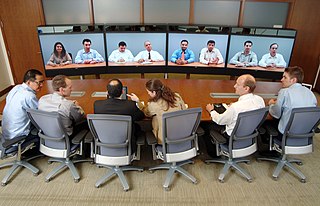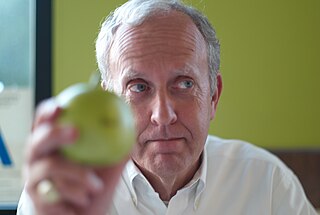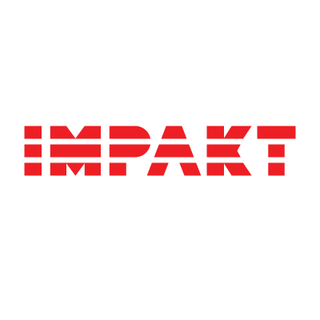Related Research Articles

Telepresence is the appearance or sensation of a person being present at a place other than their true location, via telerobotics or video.

Telerobotics is the area of robotics concerned with the control of semi-autonomous robots from a distance, chiefly using television, wireless networks or tethered connections. It is a combination of two major subfields, which are teleoperation and telepresence.

Transmediale, stylised as transmediale, is an annual festival for art and digital culture in Berlin, usually held over three to five days at the end of January and the beginning of February. transmediale takes the form of a conference, an exhibition, and a film and video programme that often contain or support performances and workshops. Throughout the year, transmediale is also involved in a number of long- and short-term cooperative projects. From its initial focus on video culture, it came to cultivate an artistic and critical dialogue with television and multimedia, emerging as the leading international platform for media art.

Scott Fisher is the Professor and Founding Chair of the Interactive Media Division in the USC School of Cinematic Arts at the University of Southern California, and Director of the Mobile and Environmental Media Lab there. He is an artist and technologist who has worked extensively on virtual reality, including pioneering work at NASA, Atari Research Labs, MIT's Architecture Machine Group and Keio University.

Sheffield DocFest is an international documentary festival and industry marketplace held annually in Sheffield, England.
The conservation and restoration of new media art is the study and practice of techniques for sustaining new media art created using from materials such as digital, biological, performative, and other variable media.
Melinda Rackham is an Australian writer, artist and curator. She is currently an adjunct research professor at the University of South Australia.
Digital curation is the selection, preservation, maintenance, collection, and archiving of digital assets. Digital curation establishes, maintains, and adds value to repositories of digital data for present and future use. This is often accomplished by archivists, librarians, scientists, historians, and scholars. Enterprises are starting to use digital curation to improve the quality of information and data within their operational and strategic processes. Successful digital curation will mitigate digital obsolescence, keeping the information accessible to users indefinitely. Digital curation includes digital asset management, data curation, digital preservation, and electronic records management.

Paulo Henrique is a Portuguese choreographer and multimedia performance artist. As a choreographer, he has created a number of performance and installation works, integrating different media such as video, sound, text, voice, and plastic arts. Since 2009 Paulo Henrique is based in Paris, France.

Berwick Film & Media Arts Festival (BFMAF) is an annual festival with a focus on new cinema and artists' moving image. The festival programme takes place across Berwick-upon-Tweed in the North East of England, UK and includes exhibitions, film screenings, live events, school screenings and family activities.

The Impakt Festival is a yearly manifestation on media art, founded in 1988 in the city of Utrecht, Netherlands.
Wendy McMurdo specialises in photography and digital media. In 2018 she was named as one of the Hundred Heroines, an award created by the Royal Photographic Society to showcase global female photographic practice.
Robots and Avatars was a programme of events and educational activities which explores how young people will work and play with new representational forms of virtual and physical life in 10–15 years time. It was produced by body>data>space with support from NESTA. between 2009 and 2012.

An exhibition, in the most general sense, is an organized presentation and display of a selection of items. In practice, exhibitions usually occur within a cultural or educational setting such as a museum, art gallery, park, library, exhibition hall, or World's fairs. Exhibitions can include many things such as art in both major museums and smaller galleries, interpretive exhibitions, natural history museums and history museums, and also varieties such as more commercially focused exhibitions and trade fairs. They can also foster community engagement, dialogue, and education, providing visitors with opportunities to explore diverse perspectives, historical contexts, and contemporary issues. Additionally, exhibitions frequently contribute to the promotion of artists, innovators, and industries, acting as a conduit for the exchange of ideas and the celebration of human creativity and achievement.

Mike Stubbs is a curator/director and filmmaker based in the UK, currently, the Creative Producer at Doncaster Creates. For 11 years he was the Director/CEO of FACT, the Foundation for Art and Creative Technology, a leading arts organisation for the commissioning and presentation of new media art forms. He has been a key contributor to the development of culture and cultural policy in Liverpool, UK. Stubbs was jointly appointed in May 2007 by Liverpool John Moores University, where he is Professor of Art, Media and Curating. He is father to two daughters Saskia and Lola Czarnecki-stubbs.

Annie Abrahams is a Dutch performance artist specialising in video installations and internet based performances, often deriving from collective writings and collective interaction. Born and raised in Hilvarenbeek in the Netherlands, she migrated to and settled in France in 1987. Her performance work challenges and questions the limitations and possibilities of online communication and collaboration. Abrahams describes her body of work as "an aesthetics of trust and attention." Studying biology became an inspiration for her future line of work. "When studying biology I had to observe a colony of monkeys in a zoo. I found this very interesting because I learned something about human communities by watching the apes. In a certain way I watch the internet with the same appetite and interest. I consider it to be a universe where I can observe some aspects of human attitudes and behaviour without interfering."
Julianne Pierce is an Australian new media artist, curator, art critic, writer, and arts administrator. She was a member of the groundbreaking group VNS Matrix. She went on to become a founding member of the Old Boys Network, another important cyberfeminist organisation. She has served as executive director of the Australian Dance Theatre and is Chair of the Emerging and Experimental Arts Strategy Panel for the Australia Council. Pierce was executive director of the Australian Network for Art and Technology (ANAT) from 2000 to 2005, based in Adelaide, and was Executive Producer of Blast Theory from 2007 to 2012, based in Brighton in the UK.
Kathy Rae Huffman is an American curator, writer, producer, researcher, lecturer and expert for video and media art. Since the early 1980s, Huffman is said to have helped establish video and new media art, online and interactive art, installation and performance art in the visual arts world. She has curated, written about, and coordinated events for numerous international art institutes, consulted and juried for festivals and alternative arts organisations. Huffman not only introduced video and digital computer art to museum exhibitions, she also pioneered tirelessly to bring television channels and video artists together, in order to show video artworks on TV. From the early 1990s until 2014, Huffman was based in Europe, and embraced early net art and interactive online environments, a curatorial practice that continues. In 1997, she co-founded the Faces mailing list and online community for women working with art, gender and technology. Till today, Huffman is working in the US, in Canada and in Europe.
Anne Barlow is a curator and director in the field of international contemporary art, and is currently Director of Tate St Ives, Art Fund Museum of the Year 2018. There she directs and oversees the artistic vision and programme, including temporary exhibitions, collection displays, artist residencies, new commissions, and a learning and research programme. At Tate St Ives, Barlow has curated solo exhibitions of work by artists including: Outi Pieski (2024); Hera Büyüktaşcıyan (2023); Burçak Bingöl (2022); Prabhakar Pachpute (2022); Thảo Nguyên Phan (2022); Petrit Halilaj (2021); Haegue Yang (2020); Otobong Nkanga (2019); Huguette Caland (2019); Amie Siegel (2018) and Rana Begum (2018). She was also co-curator of "Naum Gabo: Constructions for Real Life" (2020) and collaborating curator with Castello di Rivoli, Turin for Anna Boghiguian at Tate St Ives (2019).
shinkansen (1989–2004) was an East London sound and movement research, development and production unit focusing on body technology integration by facilitating connectivity between dance, performance, music, video and digital technologies.
References
- ↑ "Ep. 69 Ghislaine Boddington "Full Immersion"". Team Human. Retrieved 6 May 2018.
- ↑ "Ghislaine Boddington". body>data>space. Retrieved 6 May 2018.
- ↑ "shinkansen" . Retrieved 6 May 2018.
- ↑ "About". Women Shift Digital. Retrieved 6 May 2018.
- ↑ "Staff Profiles". University of Greenwich. Retrieved 6 May 2018.
- ↑ "Ghislaine Boddington". ResCen. Retrieved 6 May 2018.
- ↑ "FutureFest 2016" . Retrieved 6 May 2018.
- ↑ "Visionary Pionneer Award". Société des arts technologiques. Retrieved 6 May 2018.
- ↑ "About FutureFest". FutureFest. Retrieved 17 October 2018.
- ↑ "FutureFest Forward". Nesta. Retrieved 17 October 2018.
- ↑ "The Games Europe Plays". EUNIC London. Retrieved 17 October 2018.
- ↑ "About Us". Women Shift Digital. Retrieved 17 October 2018.
- ↑ "E-Motional". body>data>space. Retrieved 17 October 2018.
- ↑ "MADE". body>data>space. Retrieved 17 October 2018.
- ↑ "Robots and Avatars" . Retrieved 17 October 2018.
- ↑ "Robots and Avatars Forum". body>data>space. Retrieved 17 October 2018.
- ↑ "Virtual Physical Bodies". body>data>space. Retrieved 17 October 2018.
- ↑ "About Post Me_New ID". Post Me_New ID. Retrieved 17 October 2018.
- ↑ "Post Me_New ID". Kibla. Retrieved 17 October 2018.
- ↑ "Future Physical" . Retrieved 17 October 2018.
- ↑ "Commissions". Future Physical. Retrieved 17 October 2018.
- ↑ "Virtual Incarnations". LondonDance. Retrieved 17 October 2018.
- ↑ "Virtual Physical Bodies". ResCen. Retrieved 17 October 2018.
- ↑ "Connectivity". shinkansen. Retrieved 17 October 2018.
- ↑ "The Sound Works Exchange". shinkansen. Retrieved 17 October 2018.
- ↑ "Key Achievements". shinkansen. Retrieved 17 October 2018.
- ↑ "Key Achievements". shinkansen.
- ↑ "Collective Reality". body>data>space. Retrieved 17 October 2018.
- ↑ "me and my shadow". body>data>space. Retrieved 17 October 2018.
- ↑ "Dare We Do It Real Time?". body>data>space. Retrieved 17 October 2018.
- ↑ "Ideasphere". body>data>space. Retrieved 17 October 2018.
- ↑ "Ghislaine Boddington". ResCen. Retrieved 17 October 2018.
- ↑ "Performances". ResCen. Retrieved 17 October 2018.
- ↑ "Cellbytes2000". ResCen. Retrieved 17 October 2018.
- ↑ "CellBytes01". ResCen. Retrieved 17 October 2018.
- ↑ "Corpos Online". ResCen. Retrieved 17 October 2018.
- ↑ "Club Research". shinkansen. Retrieved 17 October 2018.
- ↑ "Butterfly Effect Network". shinkansen. Retrieved 17 October 2018.